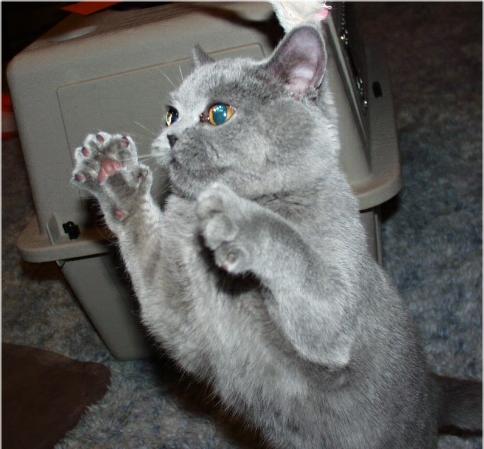Start with the Face
Your kitten's face should be the first place you start with grooming. It is particularly important to look at your kitten's eyes, checking them to make certain there are no signs of discharge. Eye discharge is a sign of respiratory infection, which is actually quite common in kittens. Therefore, if you notice any discharge, you should contact your veterinarian. If your kitten spends any time outdoors, you should also be sure to check its eyes or injuries.
Your kitten's face should be the first place you start with grooming. It is particularly important to look at your kitten's eyes, checking them to make certain there are no signs of discharge. Eye discharge is a sign of respiratory infection, which is actually quite common in kittens. Therefore, if you notice any discharge, you should contact your veterinarian. If your kitten spends any time outdoors, you should also be sure to check its eyes or injuries.

Move Onto the Ears
After inspecting the ears, it is time to move onto your kitten's ears. If your kitten was abandoned early by its mom or was otherwise removed from its mom at an early age, it may have problems with keeping its ears clean. Even if your kitten was weaned properly, however, you should still check its ears and make certain they are clean. A number of different disease can affect its ears and can cause problems with hearing. A simple cotton swab is good for cleaning its ears. Just make certain you do not stick the swab too far into the ear. In addition, if your kitten's ears are excessively dirty looking, it may have ear mites. In this case, you should consult with a veterinarian to learn more about proper treatment.
After inspecting the ears, it is time to move onto your kitten's ears. If your kitten was abandoned early by its mom or was otherwise removed from its mom at an early age, it may have problems with keeping its ears clean. Even if your kitten was weaned properly, however, you should still check its ears and make certain they are clean. A number of different disease can affect its ears and can cause problems with hearing. A simple cotton swab is good for cleaning its ears. Just make certain you do not stick the swab too far into the ear. In addition, if your kitten's ears are excessively dirty looking, it may have ear mites. In this case, you should consult with a veterinarian to learn more about proper treatment.
Look Inside the Mouth
Next, you should look inside your kitten's mouth and check for signs of gum disease or tartar build up. Although this is not very common in young cats, checking for healthy teeth is essential to the overall health of your pet. Similarly, if you notice that your cat's breath is bad, it can be a sign of more serious problems. In this case, you should make an appointment with your veterinarian in order to make certain your kitten is healthy.
Next, you should look inside your kitten's mouth and check for signs of gum disease or tartar build up. Although this is not very common in young cats, checking for healthy teeth is essential to the overall health of your pet. Similarly, if you notice that your cat's breath is bad, it can be a sign of more serious problems. In this case, you should make an appointment with your veterinarian in order to make certain your kitten is healthy.

Taking Care of the Coat
Cats have a barbed tongue that is specifically made to help them take care of their coats. With this tongue, they can easily remove loose hair and dead skin while simultaneously stimulating blood circulation. Still, kittens with long hair may have difficulty keeping themselves manicured. In addition, your cat may have some trouble with shedding its winter coat. In these cases, you may need to give your cat a good brushing.
Cats have a barbed tongue that is specifically made to help them take care of their coats. With this tongue, they can easily remove loose hair and dead skin while simultaneously stimulating blood circulation. Still, kittens with long hair may have difficulty keeping themselves manicured. In addition, your cat may have some trouble with shedding its winter coat. In these cases, you may need to give your cat a good brushing.

When brushing a kitten or an adult cat, it is best to use a brush that has fine, stiff bristles. A wire brush is usually the best option. By starting the brushing routine while your cat is still a kitten, you will have better luck with brushing it once it becomes an adult.
















